A photograph popped up on my Facebook feed recently, saying – “seven years ago today”. It was a shot of the crew from the Oil Free Seas flotilla being welcomed onto Kauaetangohia Marae at the isolated tip of the East Cape, where the rising sun first strikes our islands through the pure sea air. The iwi of that place – Te Whānau-ā-Apanui – had utterly humbled us with a 500-strong haka on the beach as we came ashore.
After the pōwhiri, there was a vast banquet of local kai moana, and non-stop performances throughout the dinner from the stage of the whare kai, which had been finely painted with the ancestral story of the tribe by Apanui artist, Cliff Whiting.
Greenpeace and a small flotilla of independent sailors had responded to the call of Apanui to join them in their resistance against Brazilian oil giant, Petrobras, which was about to begin seismic blasting in the the Raukumara basin – the iwi’s customary waters – in search for oil.
Exactly 42 days later, and the Petrobras seismic ship departed those waters. The flotilla had stayed the course and harried the oil search. The New Zealand Navy had been mobilised to board the protest ships and police had made arrests.
Iwi leader Rikirangi Gage was on board fishing boat San Pietro alongside Apanui fisherman, Elvis Teddy, when Gage stoically informed the oncoming seismic ship by radio that “we will not be moving, we will be doing some fishing”.
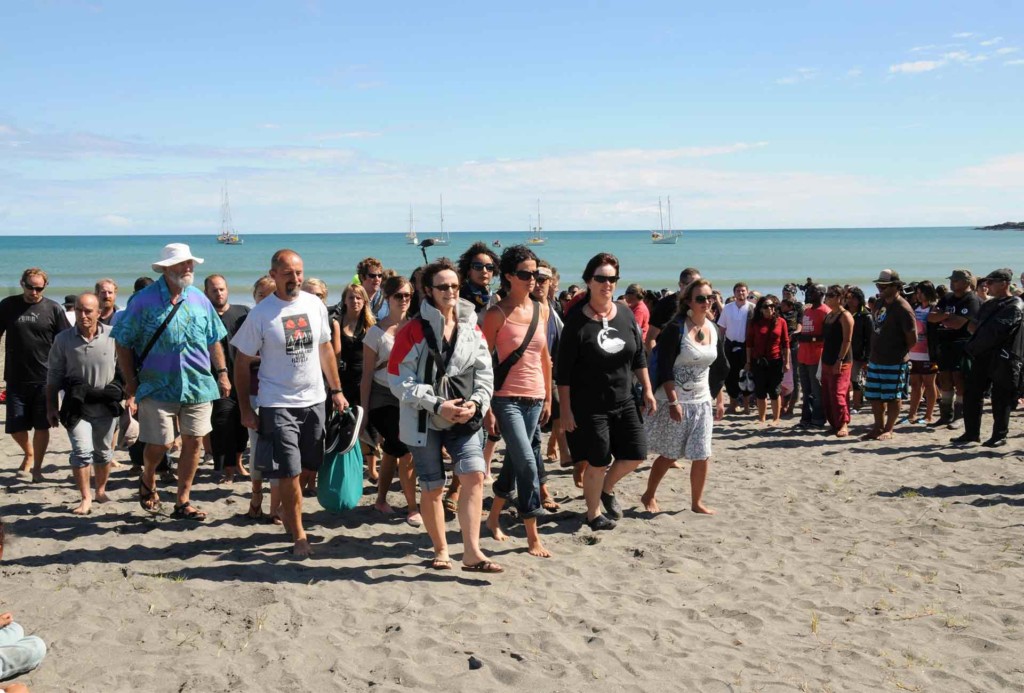
A few days earlier, activist Kylie Matthews (Ngāpuhi), had entered the dark blue water in front of the blaster with a ‘Stop Deep Sea Oil’ banner, forcing it off course. These three are surely the first among many heroes who, over coming years, would join the campaign to defend New Zealand’s waters from the invasive dangers of oil exploration.
With recent political announcements, now seems a fitting time to recount some of that history.
By the year following the first Oil Free Seas flotilla, Petrobras had relinquished their oil exploration permit and announced their exit. I distinctly remember Apanui lawyer, Dayle Takitimu – a lynchpin and stalwart of the struggle – calling to see if the reports were a ruse of some sort. In the depths of fears for a treasured home, it sometimes seemed impossible that we might succeed.
The next company to tarnish our horizon – literally, in a 34,000 tonne drillship – was Texan driller, Anadarko. Almost too bad to be true, they had a 25% interest in the worst oil disaster in history: the Deepwater Horizon blowout in the Gulf of Mexico, which spewed oil up from 1,500 metres below the surface for 87 days in 2011, choking the gulf and all the creatures that lived there in thick crude. It was a picture book apocalypse – oil on fire at sea – billowing columns of black into the sky.
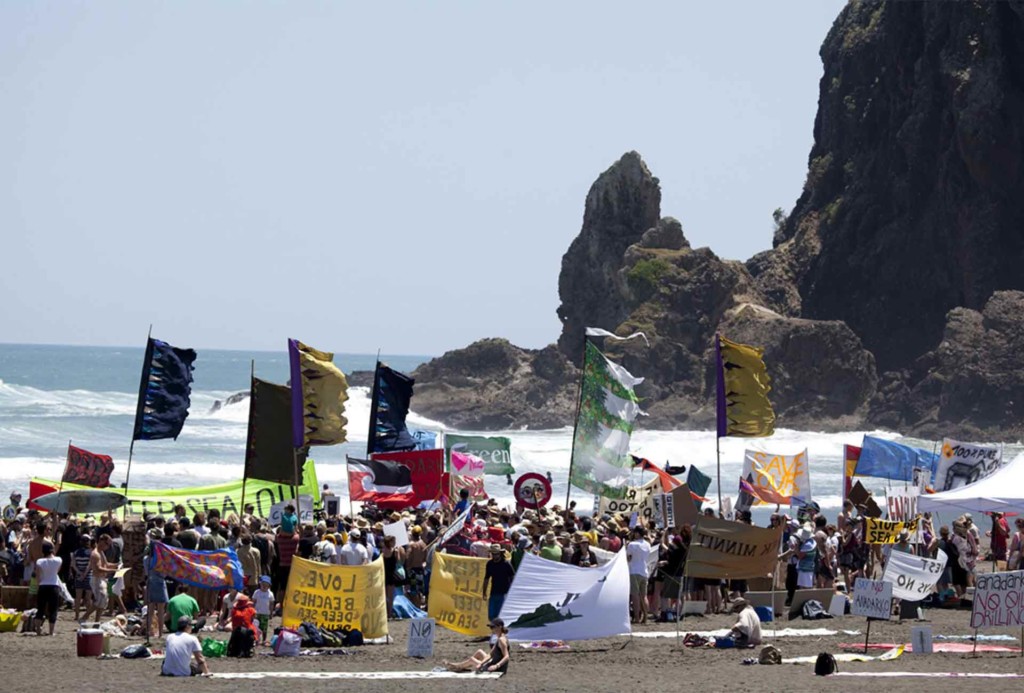
Now Anadarko were coming to our seas, both the East Coast off Kaikoura to seismic blast, and the West Coast directly off Raglan, to drill at – you guessed it – 1,500 meters.
Anadarko’s imminent arrival off Kaikoura incurred the wrath of local iwi, the wider community and eco tourism operators who, Led by Sir Mark Solomon, rallied to defend their customary waters in an unprecedented show of united protest.
And then over Easter 2013, the Minister of Energy and Resources Simon Bridges snuck out an announcement of a new draconian anti protest law designed specifically to stop groups like Greenpeace and its allies protesting against oil ships at sea. The legislation, dubbed the ‘Anadarko Amendment’, was condemned as anti-democratic by former Prime Minister, Sir Geoffrey Palmer, and public figures including Dame Anne Salmond and Sir Ted Thomas.
Not to be deterred, a new flotilla of six vessels lead by former Rainbow Warrior crew member Bunny McDiarmid, now the Greenpeace International Executive Director, set out to confront the massive Anadarko drillship – so big it looked like a floating city block – and to make a point of breaking the Anadarko Amendment’s 500-metre exclusion zone, thereby openly defying Bridges’ new law.
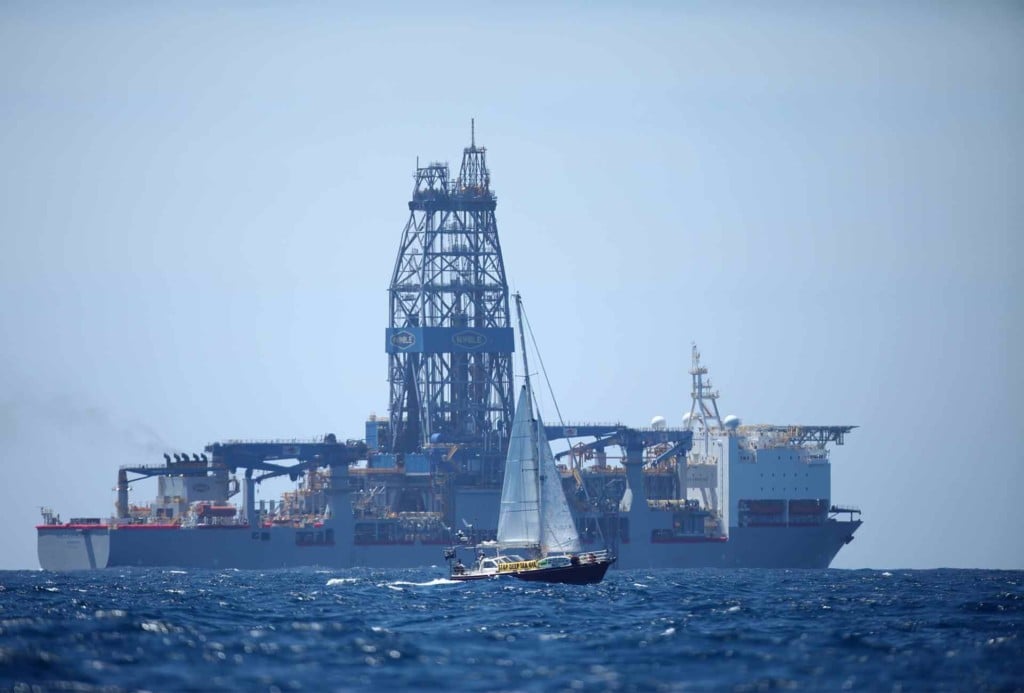
This time, the profile of the protest meant the authorities didn’t dare act. At the height of the flotilla, thousands of people painted banners and joined forces on beaches up and down the West Coast in solidarity.
Anadarko’s drilling eventually proceeded, but they didn’t find what they were looking for. A second drill attempt later on, this time off the Otago Coast, also met with protest and struck granite. As the years went by, with the oil price low and no sign of respite from protest, the Texans too gave up their interests in New Zealand.
Among many chapters in this campaign, another that stands out was the delegation to Norway of local tribal members, Te Parewhero kaumātua Te Wani Otene, and Greenpeace campaigners Hinekaa Mako and Mike Smith, seeking the support of the indigenous Saami people through their independent parliament and to make it abundantly clear that the Norwegian state driller Statoil was not welcome in Ngāpuhi’s part of the world.
The delegation had a powerful impact, inspiring the Saami President to reciprocate by making a journey to New Zealand and the Far North to meet with local iwi. On the day of her arrival, Statoil announced that they were surrendering their permit in the sacred waters of the Te Reinga basin in the Far North.
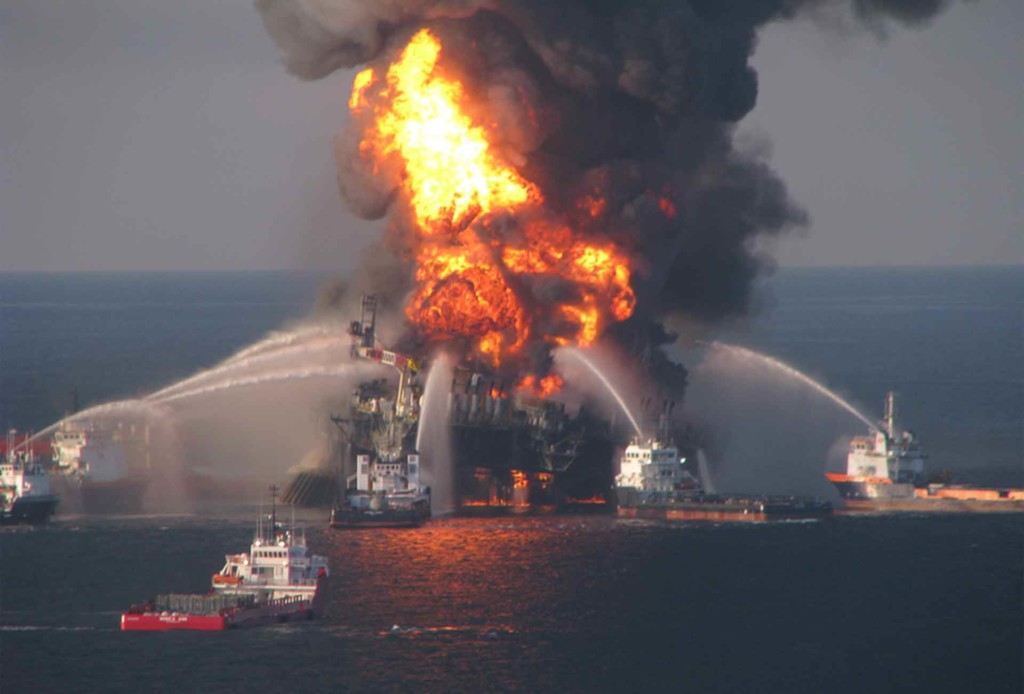
A vital aspect to the success of the seven-year oil campaign has been the alliance between Greenpeace, Māori, and the wider community.
Most recently, East Coast iwi Ngāti Kahungunu mobilised its traditional bluewater Waka Hourua, Te Matau a Māui, to challenge the world’s biggest seismic blasting ship the Amazon Warrior, AKA ‘The Beast’, as it searched for oil on behalf of Statoil, Chevron and Austrian driller OMV off the Wairarapa Coast.
Greenpeace also travelled the 60 nautical miles out to sea out to meet The Beast in crowd-funded boat, Taitu.
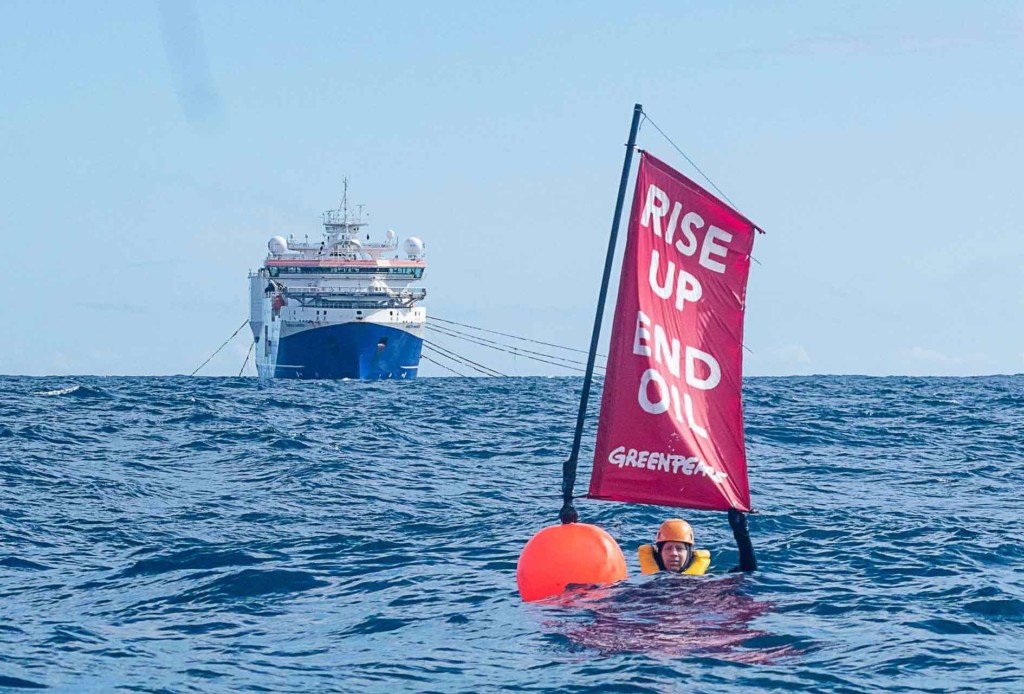
Our executive director Russel Norman, alongside volunteer Sara Howell, entered the water in front of the 125 metre long ship, forcing it to make a full turn and stop its search for oil that day. The activists and Greenpeace were charged by the oil division of the Ministry of Business Innovation and Employment (MBIE), under Bridge’s ‘Anadarko Amendment’. They are now facing a year in jail and up to $300,000 in collective fines and are preparing to fight the charges in court.
Following the Amazon Warrior’s arrival, over 80 coastal hapū declared their unanimous rejection of oil exploration, culminating in a historic agreement by the National Iwi Chairpersons Forum last December to oppose all seismic testing and oil exploration in the waters of New Zealand.
Over this time staff and volunteers have come and gone from the Greenpeace office, and all have played a part. Notably, Simon Boxer, who first devised the strategy of resisting oil drilling at sea. I also want to remember four friends we’ve lost – dedicated volunteer, Emily Drinkwater; our passionate sailor and lawyer comrade Sir Peter Williams; and another, who didn’t hesitate in making a statement in defiance of the Anadarko Amendment – Dr Ranginui Walker; and the inimitable Rata Pue who drove to the gates of Taranaki Port with a boot load of food for Lucy Lawless and the seven activists atop the the Shell drillship in 2012, and when they were released from lockup personally placed exquisite pounamu “medals” around each of their necks. Rest in peace friends – you played your part.
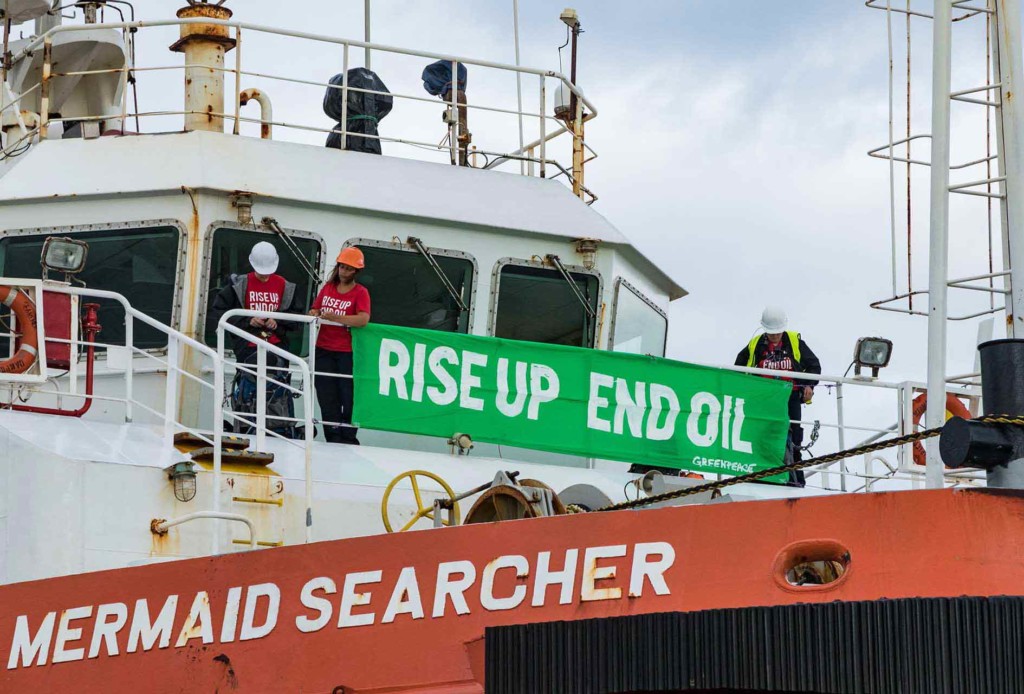
This summer the surface temperature of the Tasman peaked at six degrees above normal. The water was balmy and over many afternoons I watched the thickening grey thunderheads form over my West Auckland home. The changes are happening now, rapidly and all around us. I do fear for what the future holds.
Over the last couple of years, a new bloom of campaigners, communicators, and mobilisors have taken up the oil campaign batten, none of whom were here when this work began in 2011. These struggles are always intergenerational. A few weeks ago they drafted a heartfelt open letter to our new Prime Minister calling for an end to oil and gas exploration. Dozens of notable New Zealanders were quick to sign. The letter complimented a Greenpeace petition to the new Coalition Government, which was signed by more than 50,000 people in just a few short months.
On a sunny day outside Parliament in March, already etched in my memory, is the moment Jacinda Ardern came down in person to receive that petition. It was a poignant turn. It seemed that the winds of change were at our back, that we were close to what could be a big breakthrough for the climate movement.
I always felt we would succeed, but hoped it wouldn’t be too late to play a meaningful part in the global transformation our humanity so urgently needs to avert the existential threat of climate change.
A few weeks later, on April 12, 2018, Jacinda stood before a young crowd at Victoria University. She stood in front of the leaders of the next generation – those who will inherit our climate legacy – and declared an end to new offshore oil and gas exploration, in what is already being hailed as an historic moment for New Zealand.
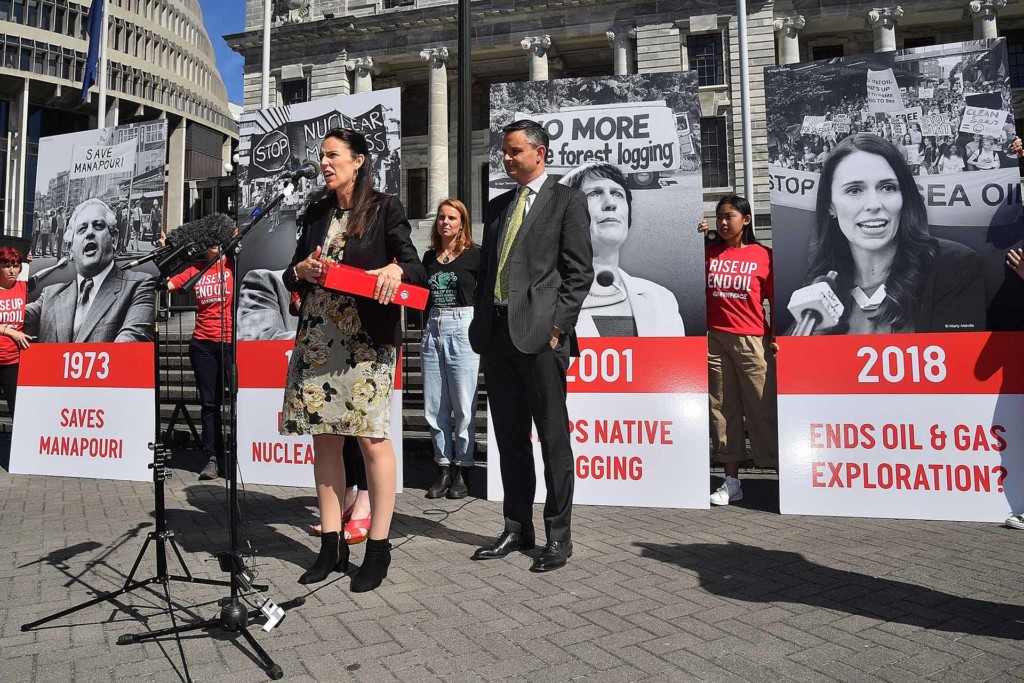
There is still work to be done. We need to end all oil and gas exploration permanently in New Zealand. As it stands, the Government’s announcement allows for both existing licences to continue, and for onshore exploration in Taranaki. Taranaki is where New Zealand’s first oil well was dug in 1865, on territory stolen from Māori. The community there still have to deal with the nightmare of ongoing fracking and exploration.
But the offshore ban is an undeniable breakthrough. It means the world’s fourth largest Exclusive Economic Zone (EEZ) has closed the door on future exploitation of the reserves of oil and gas that we must leave beneath in the seafloor if we are to avoid catastrophic climate change. By doing so we open the door to the clean energy industries that will themselves help provide a just transition for workers. It puts New Zealand back where we belong, the little country that leads globally on the issues of our era that matter most – as we did when we banned nuclear ships and gave women the vote.
In concluding her speech to the Victoria University students, Ardern said: “We can be a world leader in becoming carbon neutral. We owe this to future generations. Ultimately, we owe it to you.”
My son was born seven years ago in May. His middle name is Raukumara, named with Apanui’s blessing, after that first major struggle in modern history against the oil drillers in New Zealand. One day he might ask to know the story of how we succeeded in our resistance. I will be proud to tell him of just a few of the many thousands of good and determined people who made it happen.
